Adapting to New CMHC Policy Changes: What Investors Need to Know Part 1
Investors, the landscape for multi-unit insurance has seen some significant shifts following recent updates from CMHC (Canada Mortgage and Housing Corporation). These changes, rolled out last month, have a direct impact on how you should approach your wealth-building strategies.
Let's dive into the three key changes—two of which are positive, while the third presents a new challenge. But don’t worry, with the right approach, these changes can be navigated effectively.
"Be ready to pivot. Be ready to keep growing your wealth-building plan with us today."
The Energy Efficiency Program: A Major Shift
The most substantial change revolves around the energy efficiency program. Previously, investors could earn up to 100 points, which would qualify you for 95% loan-to-value (LTV) and a 50-year amortization under CMHC’s MLI Select financing. However, the recent adjustments have cut the maximum points available through the energy efficiency program to 50. This means that for existing buildings, your amortization is now capped at 40 years, and your LTV is limited to 85%.
For new construction, while you can still achieve a 95% LTV, your amortization is similarly capped at 40 years with the initial 50 points. This change is particularly impactful for investors in Ontario who are purchasing or refinancing existing properties. The reduction from 95% to 85% LTV and the shift from a 50-year to a 40-year amortization could significantly affect your debt coverage ratio.
Navigating the New Reality: Your Options
Given these changes, you have two primary options:
- Adapt to the New Parameters: Even with these new limitations, the terms are still competitive compared to conventional financing. You can look for properties that fit within the new guidelines and make the best of the current scenario.
- Pivot and Reassess: The keyword here is "pivot." In today’s ever-changing market, adaptability is crucial. By incorporating an affordability component into your investment strategy, you can potentially gain the additional 50 points needed to reach the full 100 points in your financing program. This might involve reassessing your current properties or exploring new opportunities that align better with the updated CMHC policies.
The Silver Lining: Opportunities Still Exist
Despite the challenges posed by these changes, there are still excellent deals available in Ontario’s market. Many investors are successfully pivoting their strategies, integrating affordability components to maximize their financing options. The key is to view these changes not as roadblocks, but as opportunities to refine your wealth-building plan.
We’re here to help you navigate these new waters. Whether it’s adjusting your current investments or exploring new ones, we’re committed to helping you grow your wealth. Remember, the market may change, but with the right approach, your investment potential remains strong. Be ready to pivot, and let’s keep building your wealth together.
If you have any questions or need assistance in adjusting your investment strategy to align with the new CMHC policies, feel free to reach out. Together, we can find the best path forward for your financial goals.





